
|
A few days before Christmas I was invited by a friend to shoot some driven roe-deer on his shooting ground on the Åland islands. I was eager to go of course, not only for the shoot but also since I got the idea to make a story out of it to our website for Christmas. It was the day before the shortest day of the year up here in the North and I was worried about the photography. Worried, not only because it is very difficult to do some serious shooting with the gun and serious shooting with the camera at the same time, but also because there was so very little light for the camera. In addition we wanted to do a number of drives during the short day that meant that I had only very little time to set up any scenes or to fiddle with the camera in general. Well, as you can see the quality of these pictures is not the best but they might do for the purpose of illustration. |
|
In the Nordic countries we have an old countryside tradition of trying to bag a hare and/or fish a pike for the Christmas dining table. I was born on the Åland islands (position: 60N20E) between Finland and Sweden and often go there hunting just before Christmas. Besides of pike in the sea and hare in the woods there is a very good roe-deer population on those islands, about the same as the human population that is 25000. Around 5000 - 6000 of them are shot every year and they make a significant contribution to the islanders diet. |

|
The roe-deer is one of the smaller deer's, but also the most common, in Scandinavia. I have saved the trophies of all the bucks I have shot as a memory. These are some of the best ones, the rest are located in another room. None of them are of medal quality. A really good roe-deer will have a weight of over 40 kilogram living weight. However most of them will add something between 10 - 15 kilogram of edible meat, including bones, to your freezer. Personally I am not much of a trophy hunter but then again I can understand those who are trying to get a particularly good buck that they have seen on their land. |
|
During the last ice age the several kilometers thick ice pressed the land down. When the ice melted away sea covered large areas of what today is called Scandinavia. Without the weight of the ice on its shoulders the land started to rise rather rapidly. The Åland islands took their first gasp of air some 4000 years ago when the first tops of the rocks broke the surface of the sea. The ice had sculptured the rocks, rounded of any sharp corners and formed valleys and hollows in a large scale. These valleys and hollows, while still under the sea, collected huge quantities of different sediments. When they rose above the sea level they were loaded with nutrition for all kind of plants. Later, when humans inhabited the islands they found the land very fertile facilitating agriculture. Besides of hunting and fishing the islanders also became skillful seamen and ship owners. As the old sailing ships used sand and rocks as ballast that had to be unloaded before any cargo was loaded or the ship maintained at local shipyards, a lot of seeds from foreign countries and continents were unintentionally imported to the islands. Some of them survived and contributed to a before unseen richness in species of herbs and plants. |
|
Early in the season the roe-deer can be stalked while it is grazing on the agricultural fields. The nights are still short and the animals must expose themself in daylight in order to get enough of food. Later in the season they are more difficlut to bag without a dog or a large scale drive with beaters and the entire organisation that comes along with such style of hunting. | 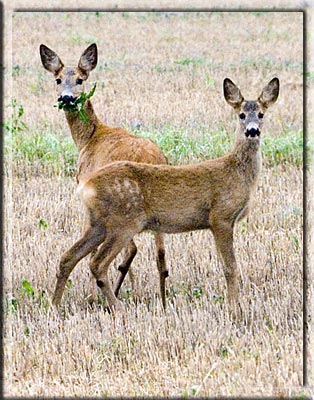
|
|
The roe deer was taken to the islands in 1959 when 50 of them were imported from Öster-Malma in Sweden. They did not need any particular care but thrive from the very start on the shattered agricultural land mixed with rocks, forest and sea bays and creeks and all the delicious plants offered by the rich nature. The first time they were hunted was in 1973 when 68 licenses were given. Today some 5000 are shot every year and a further 250 are wounded or killed in road accidents. The only threat they have today is the lynx that has, so far in very small numbers only, migrated from Finland over the wintertime ice in the eastern archipelago. |
 |
The best dogs for driving deer are short legged hounds. The most popular is the wirehaired dachshund but French breeds are gaining in popularity. This day we hunted with this young Basset Fauve de Bretagne. It was inexperienced but obedience trained to a certain degree so when a drive was over we could call it in an go to the next drive without any delay. If they have too much of prey drive and are not obedience trained at all you may just have one single drive and that's it. The rest of the day must be spent trying to find the dog, that might be hunting in some other county… |
|
There
are many ways to bag a deer. On the islands stalking and driving them with special small deerhounds is most popular. Stalking is preferred early in the season when the animals are grazing on farmed land and the kids are too small to be driven by hounds. Later, particularly when snow covers the ground, the deer will not be found on open land very often but they have their lunch and dinner in the forest were they eat lingonberry twigs. Since they often prefer heavy cover they are now very difficult to stalk. |
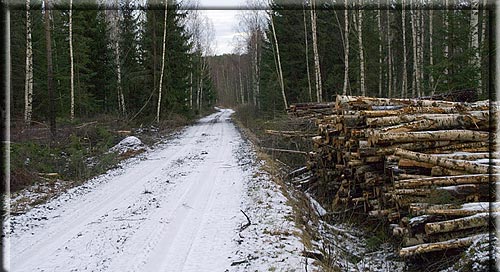

|
The perfect land for driven roe-deer shoots is shattered. Pieces of forest alternating with pieces of farmed land forms nice limits for the size of a drive. A drive can be small as 200 meters by 500 meters or like the one to left in the lower picture, 300 meters by 1500 meters. The roe-deer have their paths out of the cover and that is where the guns are placed. Then the dog handler starts the dog, taking the wind in to consideration, at one end of the drive and hopefully the deer is co-operative and moves out of the cover towards one of the pre-posted guns. Several deer can be shot in one drive by one or different guns, depending of how they move to escape. |
|
Any dog can now be used to drive or flush them out on open land. However, if you want to shoot them humanly you must select the dog very carefully. To start with you must know the land and the habits of the deer well. They have certain paths that they use when they move from one location to another. You can find these paths by learning the grounds thoroughly during of season. Before you let any dog into the piece of woods where the deer hide you have to place a gun on as many paths, at the point where they lead out to more open land, as possible. The guns must stalk their way to the post very silently and stay there as motionless as possible. It is good to pay attention to the wind direction before planning the position of the guns and the direction you try to drive the deer with the dog. |
|
Standing on the post is a bit painstaking if you are a restless person. There is no alternative to being silent and motionless, otherwise the deer will know perfectly well where you are and spare you the trouble of shooting it. The active cell-phone is a really good way to announce your presence to the deer. |
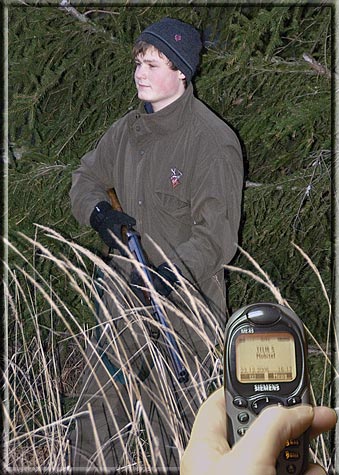 |
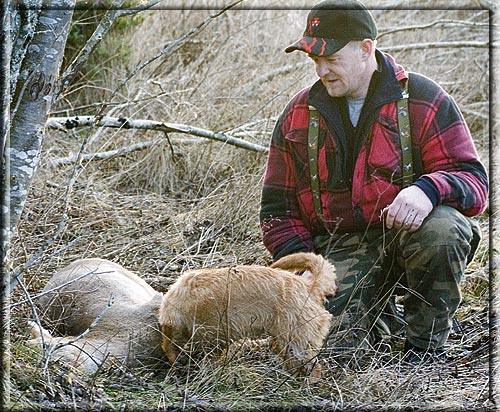
|
I
was lucky this day and already in the first drive I got the opportunity to shoot a good buck. I saw it coming from a distance but there was a birch tree between him and me all the time until he was no more than 3 - 4meters from me, first then he was clear from the birch and I could finish him with a frontal shot in the chest. I hate it when they come so close, it is easy to miss them when they cast of as they see when you raise the gun. Well, this one never noticed anything and soon the dog and then the dog handler came along to praise the young Basset. In a few years this dog will have gained a lot of experience and will replace the owners old dachshunds. Later that day I shot another deer, a kid. However it was one of the rare roe-deers that are infected by some strange virus that gives them an internal infection with a heavy diarrhoea as a result. The virus is a mystery that has not been fully solved yet. We left the kid in the woods for the foxes to eat. |
|
You can do some "sports shooting" with shotguns or rifles at deer if you use very fast dogs that really drive the deer with maximum speed. When the deer escapes in full panic it has no time to use it normal paths so you will never know at what point the deer will be clear of the cover. To compensate for this you need a lot of very skillful guns that dares to shoot at the deer when it comes at full speed. Everything happens very fast, guns will risk to shoot at each other and the land will be shattered with wounded deer, limping around for days and weeks before they die from their wounds. This type of hunting is not legal on the Åland islands! |
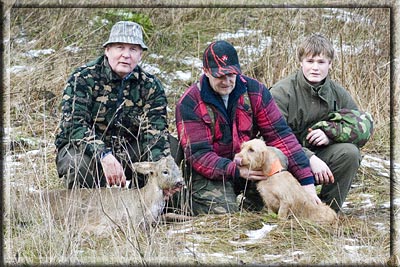
|
3 generations of dedicated hunters are posing together with the buck I shot and the Basset that produced it. The grandfather to the left, his son in the middle and his grand son to the right. All of them like to hunt everything from woodcock to moose anytime and everywhere. Do I need to say more? Well, yes! You may wonder why the buck doesn't have any antlers? They drop them before the cold winter comes and new ones grow out next spring! |
|
The other option is to use a flushing dog that does not follow the deer for more than a few seconds after it is put into motion. Spaniels and labs, wachtelhund and some terriers are common. Good and experienced older birddogs can also be used. They could not care less about the deer but they are searching for birds. That is something the deer has no idea about and it will move to a safer place when a setter or pointer comes steaming through the bushes. The deer will, when it finds out that the flushing dog does not follow it, soon calm down and move at a more comfortable speed on its usual path and hopefully into the arms of a pre-posted gun. |
|
The roe-deer is very easy to skin while it is warm. The meat is free from fat and rather tasteful but not as excellent as the fallow deer for ex. It can be cooked in many ways. Personally I like it best smoked in juniper and alder smoke. Whatever you do with it let it hang first, until tender. I have killed some 150 roe-deer after I moved together with Maud. It is the base for our food supply and 5 - 7 roe-deer is about what we care to kill and eat every year. If we kill more we trade it for moose for ex. Some years they come easy, some years there is an enormous work behind the steaks. As with most other hunting the outcome can never be calculated in advance. Whatever, the driven roe-deer shoot offers some of the best forms of social solidarity that any form of hunting can offer, no matter if the hunting party is small or large. |
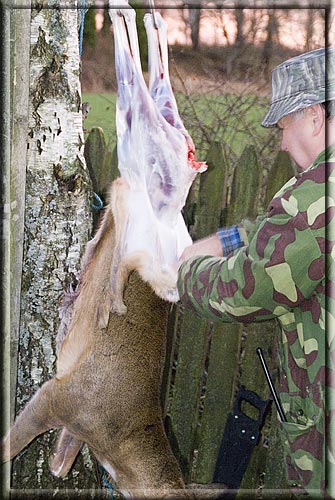 |
| The roe-deer gives a lot of opportunities to explain why this or that happened or never happened, to lie and brag, to laugh and curse. The hearth, liver and the kidneys can made into a delicious stew the same night the deer was shot. Together with some good wine they will prolong the hunting day for the party far into what we in Swedish call "the small hours". |
|
The third and most peaceful way of hunting deer with a dog is to use small, short legged and hence very slow barking dogs that drives the deer at a very moderate pace and for a limited time, say 30 - 90 minutes depending of the type of ground you are hunting on. Such a dog will put only very small pressure on the deer. Since it is constantly barking the deer knows all the time where the dog is and the slow speed of the dog will give the deer ample time to escape. Often it is seen stopping and looking back, listening to the dog, taking a bite or two from the plants under its feet and then slowly walking a distance before stopping again. It will follow a predictable path and is an easy target to the gun that has the nerves to let it move close enough. Only a few guns are needed and even a small hunting party can enjoy a day out and still have a decent bag when the sun sets in the evening. Well, that's the ways our Nordic roe-deer can be moved to a better location from their natural habitat, namely directly to the kitchen or via the freezer! |
photo: © Torsti Mäkinen & Maud Matsson, text: © Torsti Mäkinen